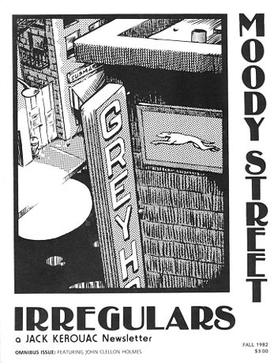At Carolina in the late 1960s /early 1970s, I was much more interested in Kerouac, William Burroughs, Richard Brautigan and Kurt Vonnegut than Melville, Emerson, Thoreau, and Hawthorne. I’m still a little embarrassed to recall that, when Walter Spearman had us announce in a book reviewing class one day what our favorite book of all time was, I said Brautigan’s The Abortion.
As I re-read in the early 1980s the canonical American lit authors in preparation for “teaching” them at ECU, I realized that being 18 or 19 might not be the best age for reading such texts. And, once I slowed my pace and read more for style than plot, I became an ardent proponent of most of those early Americans (Hawthorne excepted!): “Bartleby, the Scrivener” and “Self-Reliance” became, and remain, two of my all time favorites.
In that long process, I also went from being a Kerouac fan to an admirer (and defender) of his talents.
One of my favorite unfinished projects has been a collection that Terry Smith at North Carolina Wesleyan College Press intended to publish: Kerouac in Carolina, which would have collected excerpts from Kerouac’s published prose set in North Carolina and from the many letters he wrote from the three area homes he shared with his mother; sister, Nin, and her husband, Paul; and their infant son, Paul, Jr. Questions about rights and permissions doomed that project, but before it fell apart, I had a lot of fun tracking down those letters, especially, from their various archival homes.
So the accompanying pages are outgrowths of that research. The vagaries of my academic career combined with a personal life kept me from keeping current on what was going in Kerouac world for over 20 years, so catching up some to that has also been entertaining. Kerouac’s Book of Sketches (though it’s nearly 20 years old) has become one of my recent favorite books, and it’s informed my reading of Kerouac’s East Carolina days considerably. It could easily have been titled Kerouac at Big Easonburg & other Sketches, so heavily does it rely on his rural Rocky Mount world–with such exquisite detail and energy and style, I might add.
On the chronology page, I thought first to use just the unpublished letters that I’d collected for that long-ago and abandoned project, but Jack Kerouac: Selected Letters; Windblown World: The Journals of Jack Kerouac 1947-1954, and Atop an Underwood all provided significant additions to the project. With a couple of notable exceptions, I’ve excerpted from those otherwise available sources minimally.
One of the first things I did after moving to Greenville in 1981 was visit the Salvation Army in Rocky Mount, thinking that Kerouac may have given them his library, that maybe it would be in a backroom box. No trace. Nor in the city itself any evidence that he had been there.
Because my first publications as an assistant professor in refereed journals were about Kerouac, and the JK Literary Prize was legitimate enough to also toss into the mix for tenure & promotion, I like thinking that his having lived in Rocky Mount helped me up the academic ladder.
And to bookend with remembered embarrassments there’s that “Reply to Pancho Savery,” who caught me so badly mis-hearing a Van Morrison lyric that I’m glad Moody Street Irregulars isn’t yet online.
award
1991 Jack Kerouac Literary Prize, presented by the Lowell, Mass. Historic Preservation Commission, for Kerouac scholarship, for unpublished essay “Race, the Canon, and Kerouac”
–The award included an honorarium and expenses to Lowell for a public reading and reception that featured Ray Manzarek, the keyboardist who, with Jim Morrison, co-founded the Doors.
articles, essays, & chapters in books
“‘Running to Catch Up: Event Becoming Word’: Ammons, Kerouac, and Their New Romantic Scrolls” in Complexities of Motion: Chaos and Order in A.R. Ammons’s Long Poems, Steven P. Schneider, ed. Fairleigh Dickinson UP, 1999: 83-113.
“Before He Went West, He Had to Go South: Kerouac’s Southern Aesthetics. North Carolina Humanities. Spring 1993: 53-70.
NCH, another short-lived publication, omitted the key phrase “the South” from my thesis sentence, the last one in the first paragraph: “But in Road, Kerouac’s literary Everyman, Jack Dulouz, must first explore the South before he can consider the western possibilities.”
“Satori in Rocky Mount: Kerouac in North Carolina.” The Southern Quarterly 24.3 (Spring 1986): 35-48.
–Reprinted in The Coastal Plains: Writings on the Cultures of Eastern North Carolina. Rocky Mount, NC: NC Wesleyan College P, 1989: 81-93. Buy it.
–Reprinted in Kerouac at the Wild Boar. John Montgomery, ed. San Anselmo, CA: Fels & Firn Press, 1986: 29-38.
“Off the Road with Jack Kerouac in Rocky Mount,” News & Observer. Aug. 17, 1986: 4D.
“Kerouac and Van Morrison.” Moody Street Irregulars 15 [Music issue]: 1985.
“Reply to Pancho Savery” (6); “Kerouac in Carolina: A Chronology” (7-8); “Two Literary Notes” (37), “Kerouac in Carolina: A Guide to People, Places & References” (38-39), “Mrs. Buddhy Tom Remembers Kerouac” (39-40), Moody Street Irregulars 16-17 [numbers combined for On the Road issue]: 1986.
“Kerouac in Carolina.” The Reader: Literature, Reviews, and Commentary [Greenville, NC] 6 Feb. 1984: 3-4.
Sources
Kerouac, Jack. Atop an Underwood.
Book of Sketches, George Condo, ed.
Selected Letters 1940 – 1956. Ann Charters, ed.
Windblown World: The Journals of Jack Kerouac 1947 – 1954
–July 1, 2024
